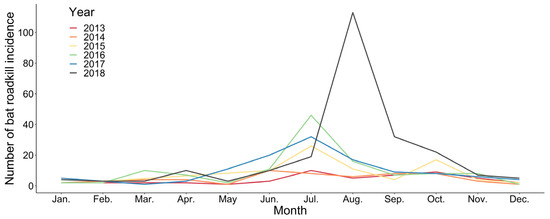Diversity 2021, 13(3), 117; https://doi.org/10.3390/d13030117
Abstract
The expansion of roads has threatened wildlife populations by driving casualties due to vehicle collisions. However, the ecological drivers of wildlife roadkills are not yet fully explored. We investigated the strength of landscape features and ecomorphological traits in determining spatial patterns of bat roadkills in Taiwan. In total, 661 roadkills that belonged to 20 bat species were acquired by citizen scientists between 2011 and 2019. The number and species richness of victim bats declined with increasing elevations with varying species compositions. Elevation and artificial light had significantly negative effects on the occurrence of roadkill, whereas protected area and its interaction with elevation had positive effects. Ordination analyses showed that roadkills were driven by different ecomorphological traits and landscape features. At low elevations, road casualties were associated with an aerial hawking hunting strategy. At higher elevations, roadkills were associated with higher elevational distribution. Roadkills of non-cave bats were associated with brighter environments, suggesting that bats might be exposed to higher risk when hunting insects near artificial light. Our findings suggest that management agencies shall consider both species traits and landscape features when planning impact assessments and mitigation practices of roadkills for bats and probably other wildlife, particularly when long environmental gradients are covered.
Keywords:
assemblage; beta diversity; citizen science; East Asia; echolocation call; hunting mode; artificial light; protected area; roost use; Taiwan roadkill observation network
